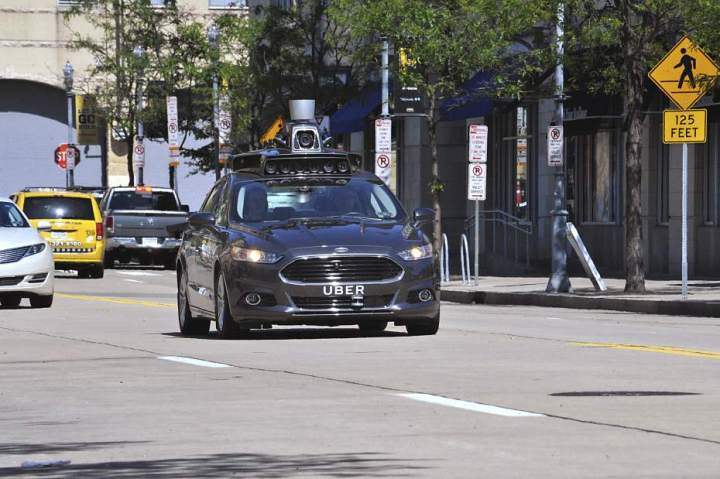
Uber’s cars sound impressive. A positioning array — a combination of 22 “cup-sized” cameras and lasers that sit atop the roof — allows the vehicles a sightline of more than 100 meters in every direction. They can brake, accelerate, and steer almost entirely autonomously, and during test drives on Wednesday with Pittsburgh Tribune-Review reporters reportedly navigated the winding, hilly streets of Pittsburgh with relative ease.
That said, Pittsburgh’s rainy and snowy weather has “made the city a challenging place” to test the fleet, head of Uber’s Pittsburgh lab John Bares told the Tribune-Review. “We’re looking for instances to make it difficult for the computer to drive,” he said. “We find those and we work on them.” He stressed, though, that vehicles have never been involved in a crash, and the lab was experimenting with special headlights capable of “shutting off certain beams of light” that might otherwise confuse the cars’ sensors. “To really advance this technology to where it needs to be, to where it is operated safely, you need to have it in these conditions,” said Bares.
The fleet isn’t entirely autonomous. In order to comply with Pennsylvania’s state Department of Transportation laws, an operator capable of assuming control must remain behind the wheel when the car is in motion, and Uber’s cars are designed with that requirement in mind. They can be switched to a “manual” driving mode at any time, and automatically disable self-driving “with a loud beep” when the onboard computer can’t determine a way around an obstacle.
Uber’s self-driving cars are the product of years of research and development. The company began prototyping vehicles “10 to 15 years ago” in the California badlands, and in 2013, founded the core of its Advanced Technology Center by controversially “poaching” 40 of Carnegie Mellon University’s National Robotics Engineer Center’s (NREC) top researchers. NREC deployed an autonomous Cadillac SRX prototype later that year, using it to ferry Pennsylvania state representatives and transport officials, and more recently tested a self-driving vehicle in Washington for “runs around the Capital Hill and the Pentagon.”
Uber’s focus on self-driving cars remains mostly technological for now, but the transportation behemoth is one of several firms that are lobbying lawmakers to formulate guidelines for self-driving technologies. Uber, along with Google, Lyft, and Volvo, formed the Self-Driving Coalition for Safer Streets in April. So far, only seven states — California, Nevada, Utah, Arizona, North Dakota, Michigan, Tennessee, Florida — and Washington, D.C. have enacted related legislation. Pennsylvania representatives are working to adopt similar laws, and the National Highway Traffic Safety Administration could move to approve a preliminary framework as soon as July.
“We all say we want to drive, but I’ve been thinking about it recently. A lot of times you’re tired, you’re distracted, do you really want to drive?” Bares said. “Can we make our road trip safe? Can we let people be productive in their cars … but be safer while they do it? So that’s the thing that tugs me, and I think we can do that over time.”
Uber’s accelerating development of its autonomous vehicles comes as it faces increased resistance from its legion of drivers. Protests in New York, San Francisco, Melbourne, New Delhi, and elsewhere have disrupted the company’s services, and Uber has encountered lawsuits over its categorization of drivers as benefit-free “contractors” rather than salaried employees. In cities like Austin, Texas, its drivers have been subject to stringent background checks. And in developing nations, the company is under pressure to reduce fares — earlier this month, Apple, a company with reported self-driving car ambitions of its own, invested $1 billion in rival service Didi Chuxing. (Uber itself is available in more than 440 cities across six continents, and privately valued at more than $62 billion.)
Uber is not putting all of its eggs in one basket. The company reportedly approached electric car company Tesla about its self-driving car tech, and last year placed an order for 100,000 autonomous Mercedes S-Class sedans.
“Are we going to be a part of the future? Or are we going to resist the future, like that taxi industry before us?” said Uber CEO Travis Kalanick at the Wall Street Journal’s WSJDLive conference in October of last year. “For us, we’re a tech company, so we’ve said, let’s be a part of that. It’s a super exciting place to be.”
Editors' Recommendations
- Tesla Autopilot vs. full self-driving: What’s the difference?
- Beleaguered robotaxi startup Cruise lays off quarter of workforce
- Cruise’s robotaxi service suspended by California regulator
- Waymo expands robotaxi service area in San Francisco
- Cruise autonomous vehicle drives over woman just after she was hit by another car

